 Avoided, underrated or just plain forgotten, Cañar is a town that’s been fighting a bad reputation for several centuries, at least among Ecuadorians. “You live in Cañar? Isn’t it cold? Isn’t it boring? Isn’t it homely? What do you do there?”I recently interviewed Padre Carlos, our neighbor priest who arrived in Cañar in 1970 as a seminary student from Colombia. “I immediately disliked the place,” he said. “It was cold and dark, with electricity only a few hours a day, no piped water, no bathrooms, streets of mud, no cars and no roads to speak of. We rode hours on horseback to reach the outlying villages.”
Avoided, underrated or just plain forgotten, Cañar is a town that’s been fighting a bad reputation for several centuries, at least among Ecuadorians. “You live in Cañar? Isn’t it cold? Isn’t it boring? Isn’t it homely? What do you do there?”I recently interviewed Padre Carlos, our neighbor priest who arrived in Cañar in 1970 as a seminary student from Colombia. “I immediately disliked the place,” he said. “It was cold and dark, with electricity only a few hours a day, no piped water, no bathrooms, streets of mud, no cars and no roads to speak of. We rode hours on horseback to reach the outlying villages.”
So let’s make a virtual visit to this “dismal place” 45 years later to see if things have changed, (with a nod and apology to the NY Times travel feature.) By the way, Padre Carlos came back in 1972 and stayed a lifetime.
Friday, 5:00 PM A fire crackles in the fireplace, and our host enjoys a beer after a hard day of troubleshooting. Earlier, he’d noticed water streaming out of the pump house, and investigating found that the pressure tank of the pump had sprung a leak. He turned off the pump, unbolted the tank from its concrete moorings and saw that a metal plate had rusted through. Announced to the guests that there would be no running water, as the city has lately turned off the water supply at night. However, there are a few gallons in plastic containers that our hostess had filled for a reserve – was that maybe last year? Oh well, We have another beer.
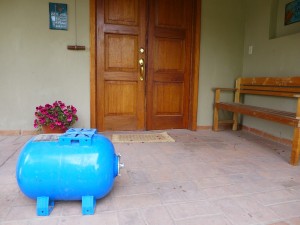
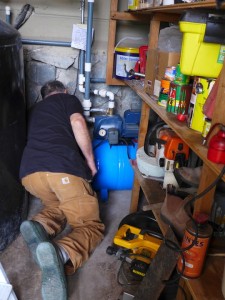 (looks new but rusted through…)
(looks new but rusted through…)
7:00 PM Dinner as planned, water or no, and our host gets to work in his new cook shack. Tonight he prepares grilled shrimp, pineapple slices and plantains, cauliflower with saffron (thanks Laura Silverman), a salad with nasturtiums, served on cosy tables in front of the fire.
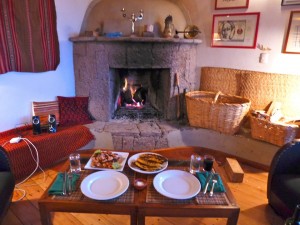
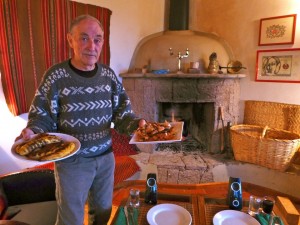
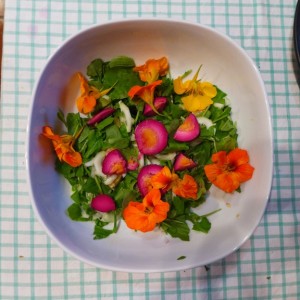
 8:00 PM After-dinner entertainment on our own: each on individual laptops with videos bought on the streets of Cuenca – many marked “for Oscar consideration only.”
8:00 PM After-dinner entertainment on our own: each on individual laptops with videos bought on the streets of Cuenca – many marked “for Oscar consideration only.”
9:00 PM As there are no cafes, theaters, movies or night life to speak of, we come to what is perhaps the most attractive feature of a visit to Cañar: nine solid hours of sleep in total darkness and quiet (except for a few barking dogs.) We are shown to our rooms carrying water jugs for brushing teeth, with the promise of running water for showers in the morning.
Saturday 9:00 AM
A glorious day after a rainy patch. Today we will visit Ingapirca, the most famous Cañari and Inca ruins in Ecuador. On the bus to Tambo (25 cents) a familiar woman gets up to tell a long story about her disabled child and the miracle of prayer. She goes on to do a few magic tricks with a cord and hankie (Michael was once the stooge; she ended up pulling a pair of red jockey shorts out of his pants), before handing out packets of candy with a Virgin of Guadalupe card in return for a contribution for her daughter’s care. Those of us who are readers-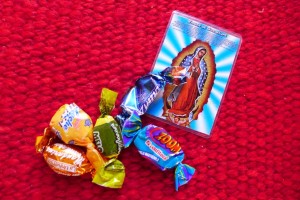 of books-on-buses, are usually annoyed by the loud voices and strong deliveries of the itinerate vendors (frequently selling bogus medical cures), but today we reward this señora for her chutzpah and magic skills.
of books-on-buses, are usually annoyed by the loud voices and strong deliveries of the itinerate vendors (frequently selling bogus medical cures), but today we reward this señora for her chutzpah and magic skills.
In Tambo we catch a local, what you might call “vintage,” bus for the spectacular ride up the mountain to Ingapirca (another 25 cents). There we find this most famous of Ecuador’s archeological sites has changed hands once again. Depending on who makes the most vigorous – and sometimes violent – claims, Ingapirca has over the years passed from the Central Bank (original owner of Ecuador’s cultural treasures) to the local townsfolk, who feel their small town – also called Ingapirca – should benefit from the admissions fees, to the indigenous Cañari who claimed it was their ancient religious site and they should therefore control it. Each group decides how much admission to charge, who will work as guides, and how the site will be run…or not. In the past there have been times when a chain across the road closed all access. (I like to think these disinterested llamas represent the competing groups.) About three years ago President Correa’s government created a new Ministry of Patrimony to take over Ingapirca and run it as a national archeological treasure should be run. HAH!
About three years ago President Correa’s government created a new Ministry of Patrimony to take over Ingapirca and run it as a national archeological treasure should be run. HAH!
“There’s only four of us here now,” the woman at the visitors’ desk said as she charged us a different admission from last year. “All the others have left or been fired. Do you want a guide? I’ll call someone from the town.” At that I knew the townsfolk have taken the complex back again. Still, the site is beautifully maintained and our town guide was knowledgable. 
12:00 PM After a leisurely, hour-long guided tour we just have time for lunch on the patio of the only restaurant, Inti Pakari ($2.50), while clouds build up and rain begins to spatter.
We run for the bus and happily doze on the trip back to Cañar. The Andean sun is fierce, the altitude at Ingapirca about 11,000 feet (3353 mts), and we’ve put in a hard day as tourists. But the weekend is not over yet!
Saturday 7:00 PM The power has gone off at our hosts’ house, so we stroll into town looking for dinner. The labyrinthine streets of Cañar offer dubious dining options, but tonight we spot what might be a refreshing new exception: a pincho stand on the street under a canopy. A young man is cooking shish kabobs (pinchos) over a charcoal fire: beef, pork, chicken and plantains. Between us we have one of each.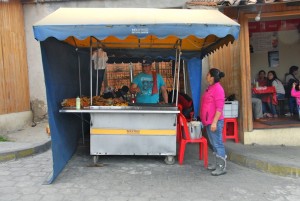
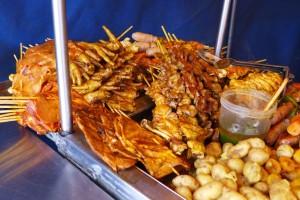
Saturday 9:00 PM We come back to our lodgings to find the lights back on. Last night was so refreshingly novel relaxing, we want to repeat the experience. A movie, book, a glass of wine on the house in front of the fire, and in bed by 9:30.
Sunday 9:00 AM
Our last day, and it’s market day! Need a cuy (guinea pig) or a couple of rabbits for dinner? A puppy for the kids? Baby chicks for the señora? A fighting cock for the señor? Cow’s heads? Geese, gloves? The feria libre is the place to be. After quiet Saturday comes chaotic Sunday, when all the streets of Cañar are turned over to commercial activity. Indigenous families come in from the country in trucks and cars (Padre Carlos remembers the first vehicle to come to Cañar, circa 1975, but now it seems like everyone has one). Town folks head out the door with baskets and rolling bags to buy their weekly groceries. So much more fun than going to the supermarket.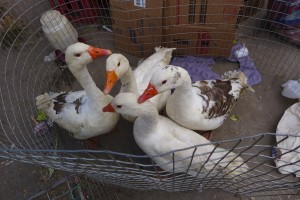
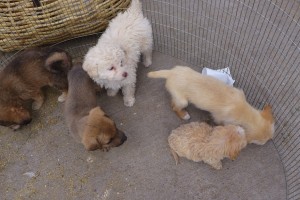
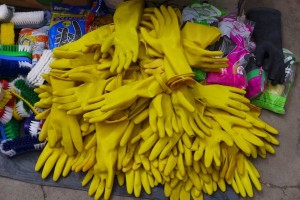
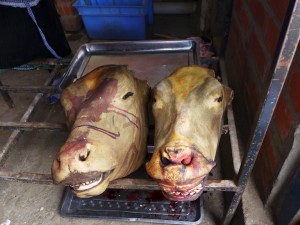
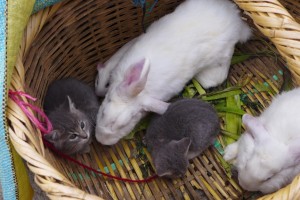
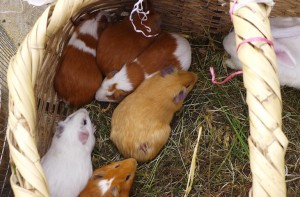
Before we head back to the PanAmerican to catch our bus for Cuenca, we take a quick peek inside the main church and say hello to San Antonio, Cañar’s patron saint kept warm by an endless supply of knit scarves and ponchos. We are also so pleased to see they allow dogs in church here. 
 So that’s it: 36 hours in Cañar, a place like no other, and no other place we would rather be.
So that’s it: 36 hours in Cañar, a place like no other, and no other place we would rather be.
(Note: All of the above happened within the last two weeks (e.g. no water, no lights), although I have conflated a couple of events (and we didn’t really eat those pinchos, but had dinner again at Chez Michael).

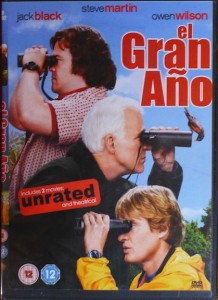

Great post, Judy! I hope one day we can do at least 36 hours with you in Canar!
Judy,
Thanks so much. I saw the first photo and I thought, my God Canar has not changed a bit from when I lived there in the 1960s but then I saw the next photo that showed how much it has changed.
Love to get back out there sometime to meet up with Jose Quinones and Pio Alberto,
Jeff
Wow, the last photo (interior church) was a surprise. So lavish, like the churches I saw in Brazil. What’s the history of this church, I’d be interested to know?
Hi Jude, Loved your post once again.
Great photos! I enjoyed you being a guest in your own home.
Thank you for sharing your place in the clouds where
I can’t visit. You and Chef Michael will perhaps consider a trip
to Nicaragua in the near future? Sea level and maybe a fish or two.
Love sister Char
Hola, Judy y Miguel! Su diario fue estupendo! Con la sequía el calentamiento global en Portland, podrás inspirar un éxodo masivo a Shangra-Canar. –Bruce
I am hoping to rent from you and your “host” when you get set up on AirBnB! Hilarious, pitch perfect advertisement to enjoy and eating and sleeping stopover at a certain house in the clouds. . . You are a brave woman for putting this out there on the Web, including such delectable looking photos!
Wait, how did I miss this hilarious post? And I even got a mention! Wasn’t that Ottolenghi cauliflower divine? Your pace of life sounds quite similar to ours, especially in the cold weather. Nothing wrong with that!
Yes, that cauliflower was inspired by your post, and the great number of florets in our kitchen garden. Thank you ! Pace of life: you mean no lights, no water, especially when guests are expected?